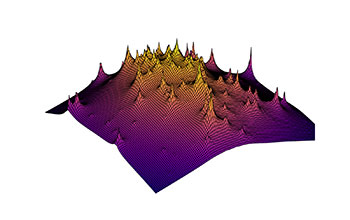Multimedia Gallery
Dark matter map
A detailed map of reconstructed dark matter clump distributions in a distant galaxy cluster, obtained from the Hubble Space Telescope Frontier Fields data. The unseen matter in this map is comprised of a smooth heap of dark matter on which clumps form.
More about this image
A international team of researchers led by Priyamvada Natarajan, an astrophysicist at Yale University, produced one of the highest-resolution maps of dark matter ever created. The map offers a detailed case for the existence of cold dark matter, sluggish particles that comprise the bulk of matter in the universe.
The dark matter map is derived from Hubble Space Telescope Frontier Fields data of a trio of galaxy clusters that act as cosmic magnifying glasses to peer into older, more distant parts of the universe, a phenomenon known as gravitational lensing.
The team analyzed the Hubble images. "With the data of these three lensing clusters we have successfully mapped the granularity of dark matter within the clusters in exquisite detail," Natarajan said. "We have mapped all of the clumps of dark matter that the data permit us to detect, and have produced the most detailed topological map of the dark matter landscape to date."
Scientists believe dark matter -- theorized, unseen particles that neither reflect nor absorb light, but are able to exert gravity -- may comprise 80 percent of the matter in the universe. Dark matter may explain the very nature of how galaxies form and how the universe is structured. Experiments at Yale and elsewhere are attempting to identify the dark matter particle; the leading candidates include axions and neutralinos.
This research was funded in part by the National Science Foundation.
To learn more about this research, see the Yale news story Yale-led team puts dark matter on the map. (Date image taken: March 2017; date originally posted to NSF Multimedia Gallery: May 3, 2017)
Credit: Yale University
See other images like this on your iPhone or iPad download NSF Science Zone on the Apple App Store.
Images and other media in the National Science Foundation Multimedia Gallery are available for use in print and electronic material by NSF employees, members of the media, university staff, teachers and the general public. All media in the gallery are intended for personal, educational and nonprofit/non-commercial use only.
Images credited to the National Science Foundation, a federal agency, are in the public domain. The images were created by employees of the United States Government as part of their official duties or prepared by contractors as "works for hire" for NSF. You may freely use NSF-credited images and, at your discretion, credit NSF with a "Courtesy: National Science Foundation" notation.
Additional information about general usage can be found in Conditions.
Also Available:
Download the high-resolution JPG version of the image. (1016.6 KB)
Use your mouse to right-click (Mac users may need to Ctrl-click) the link above and choose the option that will save the file or target to your computer.

